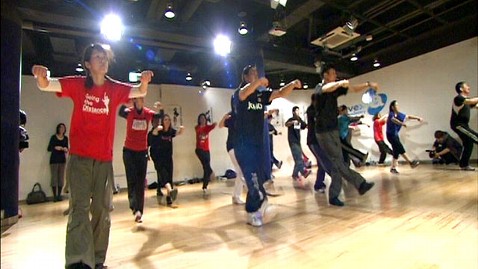Japanese Teachers Take on Hip-Hop

(Image Credit: ABC News)
TOKYO - The start of a new school year always brings new challenges, but teachers in Japan face a particularly high hurdle this year, mastering the art of street or hip-hop dancing.
New government education guidelines require all seventh- and eighth-grade students to take dance and martial arts classes as part of their physical education curriculum, a mandate that has forced rhythmically challenged teachers to enroll in dance courses themselves before the new school year begins in April.
Track-and-field coach Masamitsu Furusawa, 54, diligently took notes in Tokyo Tuesday night as the dance instructor explained the history of hip-hop.
"Rap, graffiti, and DJs played a huge role in influencing the movement," the instructor said.
When it came time to move his body, Furusawa struggled to keep up. He seemed out of breath, swaying side to side, often looking around for guidance as younger teachers jumped and kicked their way on the dance floor. The "running man" dance came a little easier.
"I've taken aerobics classes before, so I did better than I expected," Furusawa said, wiping the sweat from his forehead. "I doubt others saw it that way."
The government initially proposed the new P.E. guidelines four years ago to make physical education "a more fulfilling experience," Ken Watanabe of the Ministry of Education's youth sports department said. While dance and martial arts classes were optional, officials wanted to make them compulsory, like swimming and track and field, to expose students to new activities.
Starting next month, middle schools will be required to teach students either, sumo, judo, or kendo, all traditional Japanese sports.
They must also offer courses in folk, creative or street dancing. Teachers have been so eager to pick up the latter, because of the overwhelming interest among students.
"When you break it down [with other sports], students will only end up taking 12 hours of dance and martial arts per year," Watanabe said. "We realize that's not a lot, but our hope is they'll find a sport they'll want to continue, beyond middle school."
Watanabe also hopes the new curriculum expands students' cultural knowledge. He's particularly excited about their exposure to martial arts, and says an overwhelming number of schools are expected to offer judo over sumo and kendo, because of cheaper equipment costs.
"Martial arts is a big part of Japanese culture," he said. "[Through judo] students will learn how to bow properly, the importance of valuing an opponent, the proper way to wear a 'dogi ,' or judo gear."
Coach Furusawa is too overwhelmed with hip-hop to think about judo. He has just a few days left to master the dance, and knows the learning curve is steep.
"Once school starts, I have to lead students in the course," he said. "I need to be confident enough to say, 'I know better, listen to me."